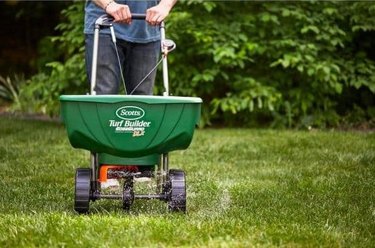The Scotts spreader series includes several types of spreaders used to apply lawn care products. Settings for spreaders are specified on the bag of Scotts fertilizer, grass seed, and other products. The type of spreader, your walking speed, and the particular product are all factors in setting the size of the openings on a Scotts broadcast or drop spreader.
Scotts Broadcast Spreader Settings
Video of the Day
Scotts broadcast spreaders scatter grass seed or fertilizer over a wide area as you walk. There are several models to accommodate small or large yards. The Scotts Whirl Hand Powered Spreader is suitable for yards under 1,500 square feet, while the Scotts Turf Builder EdgeGuard Mini Broadcast Spreader is intended for areas up to 5,000 square feet. Landscapes over 5,000 square feet are best handled with the Scotts Turf Builder EdgeGuard DLX Broadcast Spreader or Scotts Elite Spreader.
Video of the Day
After choosing the best broadcast spreader for your yard, locate the orange dial on the spreader and turn it to the setting indicated on the seed or fertilizer bag. Turn clockwise for a higher setting of 12 or 14, which is for larger granules or grass seed, or counterclockwise to reach a lower setting of three or five. Make sure the hopper is closed and then fill it with the product.
Begin walking and open the hopper to distribute the product. Close the hopper at the end of each pass, turn the spreader, and align it to line up with the edge of the previous pass. Begin walking and open the hopper for the next pass. Close the hopper at the end of the last pass.
Scotts Turf Builder Spreader Settings
When applying product in tight spaces, drop spreaders provide a narrow swath depending on the width of the spreader. At 22 inches wide, the Scotts Turf Builder Classic Drop Spreader has a large capacity hopper that holds enough product to cover up to 10,500 square feet of lawn.
Set the dial on the spreader at the recommended setting indicated on the grass seed or fertilizer bag, turning clockwise for larger granules or counterclockwise for smaller. Close the hopper and then add the product. Begin walking and open the hopper at the edge of the lawn. Overlap each swath over the yard by lining up the arrow on the hopper with the wheel track from the previous pass.
Annual Calibration of Your Spreader
To ensure a consistent result year after year, calibrate your spreader at least once a year. While the spreader settings are calculated at an assumed walking pace of 3 1/2 miles per hour, your pace may be faster or slower depending on your height, the length of your stride, and your physical ability. Mark off 50 to 100 feet in a straight line if possible with a tape measure. Multiply the length by the width of your spreader's coverage to find the square feet of the test area.
Check the instructions on the bag for the recommended setting for that particular product and set the dial accordingly. With the hopper closed, measure out 5 or 10 pounds of product. Begin walking at a steady pace, open the hopper at the start line, and close it at the finish line.
Weigh the remaining product to determine the amount used. For example, if you used the Scotts spreader setting for fertilizer and distributed 1 1/4 pounds of product over a 250 square-foot area, that is equivalent to 5 pounds of product for every 1,000 square feet. Adjust your settings if necessary to distribute the correct amount of lawn care product onto your lawn.
Follow Safety Precautions
Whenever you are working with seeds, fertilizer, herbicides, or soil amendments, put on safety goggles, a dust mask, gloves, long pants, and closed-toe shoes to protect your eyes, lungs, and skin. Keep children, pets, and bystanders out of the area.
After applying the product, sweep the excess off driveways and sidewalks to prevent it from washing into storm drains, which can adversely affect waterways. Pour unused product back into the bag and close it securely. Wash the spreader thoroughly and allow it to air dry before storing it for your next use.
